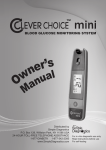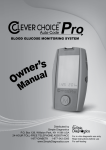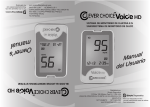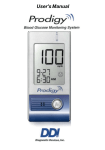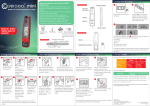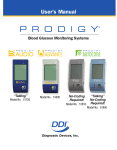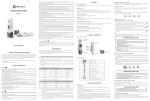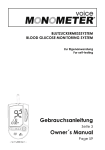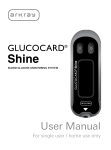Download Clever Choice Voice+ Owner`s manual
Transcript
BLOOD GLUCOSE METER ’s r e n al w O anu M Distributed by Simple Diagnostics P.O. Box 128, Williston Park, NY 11596 USA 24-HOUR TOLL-FREE TELEPHONE ASSISTANCE 1-877-DIABETK 1-877-342-2385 www.SimpleDiagnostics.com For in vitro diagnostic use only Read instructions before use For self-testing BLOOD GLUCOSE METER OWNER'S MANUAL June 2011 Versión 1.0 Dear CLEVER CHOICE Voice+ Blood Glucose Meter Owner: Thank you for purchasing the CLEVER CHOICE Voice+ Blood Glucose Meter. This manual provides important information to help you to use the system properly. Before using this product, please read the following contents thoroughly and carefully. Regular monitoring of your blood glucose levels can help you and your doctor gain better control of your diabetes. Due to its compact size and easy operation, you can use the CLEVER CHOICE Voice+ Blood Glucose Meter to easily monitor your blood glucose levels by yourself anywhere, any time. If you have other questions regarding this product, please contact the place of purchase or call Customer Service at 1-877-DIABETK (1-877-342-2385) for support. IMPORTANT SAFETY PRECAUTIONS READ BEFORE USE The meter and lancing device are for single patient use. Do not share them with anyone including other family members! Do not use on multiple patients! All parts of the kit are considered biohazardous and can potentially transmit infectious diseases, even after you have performed cleaning and disinfection. For more information, please visit 1.“FDA Public Health Notification: Use of Fingerstick Devices on More than One Person Poses Risk for Transmitting Bloodborne Pathogens: Initial Communication” (2010) http://www.fda.gov/MedicalDevices/Safety/AlertsandNotices/ ucm224025.htm 2.“CDC Clinical Reminder: Use of Fingerstick Devices on More than One Person Poses Risk for Transmitting Bloodborne Pathogens” (2010) http://www.cdc.gov/injectionsafety/FingerstickDevicesBGM.html 1. Use this device ONLY for the intended use described in this manual. 2.Do NOT use accessories which are not specified by the manufacturer. 3.Do NOT use the device if it is not working properly or if it is damaged. 4.Do NOT use the equipment in places where aerosol sprays are being used or where oxygen is being administered. 5.Do NOT under any circumstances use the device on neonates. 6. This device does NOT serve as a cure for any symptoms or diseases. The data measured is for reference only. 7.Before using this device to test blood glucose, read all instructions thoroughly and practice the test. Carry out all the quality control checks as directed. 8.Keep the device and testing equipment away from young children. Small items such as the battery cover, batteries, test strips, lancets and vial caps are choking hazards. 9.This system is not intended for use in the diagnosis or screening of diabetes mellitus. KEEP THESE INSTRUCTIONS IN A SAFE PLACE 6 TABLE OF CONTENTS BEFORE YOU BEGIN Important Information 9 9 Intended Use 10 Test Principle 10 Contents of System 11 Meter Overview 12 Display Screen 13 Test Strip 14 Speaking Function 13 Setting the Meter 19 BEFORE TESTING 23 Control Solution Testing 23 Performing a Control Solution Test 24 TESTING WITH BLOOD SAMPLE 27 Overview of the Lancing Device 27 Preparing the Puncture Site 28 Alternative Site Testing 30 Performing a Blood Glucose Test 32 METER MEMORY Reviewing Test Results 35 35 Reviewing Blood Glucose Day Average Results 36 Downloading Results onto a Computer 38 7 MAINTENANCE 39 Caring for Your Meter 41 Caring for Your Test Strips 45 Important Control Solution Information 46 SYSTEM TROUBLESHOOTING 47 Result Readings 47 Error Messages 48 Troubleshooting 50 DETAILED INFORMATION 52 Reference values 52 Comparing Meter and Laboratory Results 53 SPECIFICATIONS 8 39 Battery 55 BEFORE YOU BEGIN Important Information Severe dehydration and excessive water loss may cause readings which are lower than actual values. If you believe you are suffering from severe dehydration, consult a healthcare professional immediately. If your blood glucose results are lower or higher than usual, and you do not have any symptoms of illness, first repeat the test. If you have symptoms or continue to get results which are higher or lower than usual, follow the treatment advice of your healthcare professional. Use only fresh whole blood samples to test your blood glucose. Using other substances will lead to incorrect results. If you are experiencing symptoms that are inconsistent with your blood glucose test results and you have followed all the instructions given in this owner’s manual, contact your healthcare professional. We do not recommend using this product on severely hypotensive individuals or patients in shock. Readings which are lower than actual values may occur for individuals experiencing a hyperglycemic-hyperosmolar state, with or without ketosis. Please consult the healthcare professional before use. Critically ill patients should not be tested with a blood glucose meter. 9 Intended Use The CLEVER CHOICE Voice+ Blood Glucose Monitoring System is intended for use in the quantitative measurement of glucose in fresh capillary whole blood from the finger and the following alternative sites: the palm, the forearm, the upper-arm, the calf and the thigh. It is intended for use by people with diabetes mellitus at home as an aid in monitoring the effectiveness of diabetes control program. It is not intended for the diagnosis of or screening for diabetes mellitus, and is not intended for use on neonates. The alternative site testing in this system can be used only during steady-state blood glucose conditions. The CLEVER CHOICE Voice+ Blood Glucose Monitoring System is intended to be used by a single person and should not be shared. This system contains a speaking functionality which provides step by step instructions to aid visually impaired persons. Test Principle Your system measures the amount of sugar (glucose) in whole blood. The glucose testing is based on the measurement of electrical current generated by the reaction of glucose with the reagent of the strip. The meter measures the current, calculates the blood glucose level, and displays the result. The strength of the current produced by the reaction depends on the amount of glucose in the blood sample. 10 Contents of System Your new CLEVER CHOICE Voice+ Blood Glucose Meter kit includes: Meter Daily Log Book Owner’s Manual Warranty Card Protective Wallet 2 x 1.5V AAA alkaline batteries Quick Start User Guide Quick Start User Guide Test strips, control solution, or sterile lancets may be purchased separately. NOTE If any items are missing from your kit or opened prior to use, please contact local customer services or place of purchase for assistance. There are two levels of CLEVER CHOICE control solution available, normal and high. Please contact the place of purchase for more information. This CLEVER CHOICE Voice+ Blood Glucose Meter must be used with CLEVER CHOICE Voice+ Test Strips. 11 Meter Overview Front Display Screen Test Strip Ejector Eject the used strip by pushing up this button. Test Slot Insert test strip here to turn the meter on for testing. Up Button & Back Button Enter and confirm the meter settings. Earphone Port Insert earphones to listen the voice messages. Data Port Down Button Download test results with a cable connection. Select or change information. Repeat Button Button Replay the previous recording Enter the meter memory and while operating the meter. silence a reminder alarm. Battery Compartment 12 Display Screen Low battery symbol Time Test strip symbol Ketone warning Blood drop symbol Day average Volume symbol Measurement unit Test result Control solution mode Memory symbol Error message Date 13 Test Strip Absorbent Hole Apply a drop of blood here and the blood will be drawn in automatically. Confirmation window Confirm if enough blood has been applied to the absorbent hole of the test strip. Test Strip Handle Hold this part to insert the test strip into the slot. Contact Bars Insert this end of the test strip into the test slot. Attention! Test results might be wrong if the contact bar is not fully inserted into the test slot. The front side of the test strip should face up when inserting the test strip. Frente Reverso NOTE The CLEVER CHOICE Voice+ Blood Glucose Meter should only be used with CLEVER CHOICE Voice+ Test Strips. Using other test strips with this meter can produce inaccurate results. 14 Speaking Function CLEVER CHOICE Voice+ Blood Glucose Meter “speaks” aloud with step by step instructions to guide you through the process of setting up your meter and blood glucose testing. The following table tells you when and what the meter “speaks”. WHEN does the meter speak? WHAT does the meter speak? Setting up the meter Choosing the language You are now in setting mode. Thank you for using this product. Setting the voice volume Voice volume is (number). Setting the year The Year is (number). Setting the month The month is (month). Setting the date The date is the (number). Setting the hour The hour is (number) PM/AM. Setting the minutes The minutes are (number). 1. Delete memory record function. Press Up key to clear all records. Deleting the memory 2. Are you sure you want to clear ALL records? Press Up key again to clear all records. 3. All memory record have been deleted. 15 1. The (first/second/third/fourth) alarm is disabled/enabled. 2. The (first/second/third/fourth) alarm hour is (number) AM/PM. Setting the alarm 3. The (first/second/third/fourth) alarm minutes are (number). 1. Today’s date is (week day) (month) (day), (year). 2.The time is (hour minute) AM/ PM. 3.Blood glucose unit is milligrams per deciliter. At the end of the meter setting 4.Voice volume is (number) 5.First alarm is enabled for (time) AM/PM. Second alarm is enabled for (time) AM/PM. Third alarm is enabled for (time) AM/PM. Fourth alarm is enabled for (time) AM/ PM. 6.Have a nice day. WHEN does the meter speak? WHAT does the meter speak? Using the meter 16 When switching on the meter Thank you for using this product. When room temperature is outside operating range, which is 50°F-104°F(10°C40°C). Room temperature is out of range, thus unable to measure. 1. Test strip inserted. Insert test strip 2.Today’s date is (week day) (month) (day), (year). When the meter is ready to test. (symbol appears on display) 3.The time is (hour minute) PM/ AM. After sample is applied onto the test strip Now testing. When the test is completed. Your blood glucose is (number) milligrams per deciliter. (result appears on display) 4.Please apply blood onto the test strip. When the test result is < 20 mg/dL Your blood glucose is less than 20 milligrams per deciliter. When the test result is > 600 mg/dL Your blood glucose is over 600 milligrams per deciliter. When selected CTL for control solution testing You are now in control solution mode. 1. Thank you for using this product. 2. Today’s date is (week day) (month) (day), (year). 3. The time is (hour minute) AM/ PM. Recall the Stored Test Results 4. Press M key for memory recall mode. 5. Memory record for (week day) (month) (day), (year) (hour minute) AM/PM. 6. Your blood glucose was (number) milligrams per deciliter. 17 1. Thank you for using this product. 2. Today’s date is (week day) (month) (day), (year). Reading the Average of Blood Glucose Results 3. The time is (hour minute) AM/ PM. 4. Press M key for memory recall mode. 5. The (number) day blood glucose average is (number) milligrams per deciliter for (number) records. If no results stored in memory No memory record available. Downloading results from your meter onto the computer Connecting to your computer. NOTE If you would like to listen to the voice messages by earphone, you can plug the earphone into the earphone port on the side of your meter. 18 Setting the Meter Before using your meter for the first time or if you change the meter battery, you should check and update these settings. Make sure you complete the steps below and have your desired settings saved. Entering the Setting Mode Start with the meter off (no test strip inserted). Press and firmly hold for 3 seconds until the meter turns on. 1. Choosing a Language Press or to select L1/L2.The default language for the meter is L1, which is English. L2 is Spanish. To confirm your selection, press . 2. Setting the speaking volume There are seven (7) speaking volume options to choose from. Press or until the desired speaking volume appears. To confirm your selection, press . Volume 0 indicates that the speaking function is ” will not display during testing. turned off, and “ Volume 1 to 7 indicates speaking volume from low to high, and “ ”will be displayed throughout the testing. 19 3. Setting the date With the year flashing, press rect year appears. Press . or or With the month flashing, press rect month appears. Press . With the day flashing, press day appears. Press . until the cor- or until the cor- until the correct 4. Setting the time With the hour flashing, press rect hour appears. Press . With the minute flashing, press rect minute appears. Press . 20 or until the cor- or until the cor- 5. Deleting the memory With “dEL” and a flashing “ keep the results in memory. ” symbol on the display, press to ” and “ ” are displayed To delete all the results, press twice. “ on the meter, which indicates that all data stored is deleted. 6. Setting the reminder alarm You may set up the reminder alarm. The meter displays “OFF” or “On” with , press or to turn on or turn off to set the reminder alarm. Press or to select “On”, then press to set the hour. When the hour is flashing, press or to add an hour. Press to confirm and go to minutes, press or to add one minute. Hold or longer to add faster. Press to confirm the first alarm setting. 21 If you do not want to set an alarm, press this step. and select “OFF” to skip Setup the remaining three reminder alarms by following instructions above. Press to turn off the meter. The meter repeats all your settings before shutdown. Congratulations! You have completed all settings! If you want to turn off an alarm, find the alarm number by pressing Set in the setting mode, press to change from “ON’ to “OFF”. At the time of your alarm, the meter will beep and automatically turn on. You can press to silence the alarm and insert a test strip to begin testing. If you do not press , the meter will beep for 2 minutes then switch off. If you do not want to test at this time, press to switch off. NOTE These parameters can ONLY be changed in the setting mode. If the meter is idle for 3 minutes during the setting mode, it will switch off automatically. 22 BEFORE TESTING Control Solution Testing CLEVER CHOICE Control Solution contains a known amount of glucose that reacts with test strips and is used to ensure your meter and test strips are working together correctly. Do a control solution test when: you first receive the meter, at least once a week to routinely check the meter and test strips, you begin using a new vial of test strips, you suspect the meter or test strips are not working properly, your blood glucose test results are not consistent with how you feel, or if you think the results are not accurate, practicing the testing process, or you have dropped or think you may have damaged the meter. 23 Performing a Control Solution Test 1. Insert the test strip to turn on the meter Insert the test strip into the meter. Wait for the meter to display the test strip and blood drop symbols. 2. Press to mark this test as a control solution test With “CTL” displayed, the meter will not store your test result in memory. If you press again, the “CTL” will disappear and this test is no longer a control solution test. WARNING When doing the control solution test, you have to mark it so that the test result will not be stored in the memory. Failure to do so will mix up the blood glucose test results with the control solution test results in memory. 24 3. Apply Control Solution Shake the control solution vial thoroughly before use. Squeeze out a drop and wipe it off, then squeeze out another drop and place it on the tip of the vial cap. Hold the meter to move the absorbent hole of the test strip to touch the drop. Once the confirmation window fills completely, the meter will begin counting down. To avoid contaminating the control solution, do not directly apply control solution onto a strip. 4. Read and Compare the Result After counting down to 0, the control solution test result will appear on the display. Compare this result with the range printed on the test strip vial and it should fall within this range. If not, please read the instructions again and repeat the control solution test. Normal 109~165 25 Out-of-range results If you continue to have test results fall outside the range printed on the test strip vial, the meter and strips may not be working properly. Do NOT test your blood. Contact the local customer service or place of purchase for help. NOTE The control solution range printed on the test strip vial is for control solution use only. It is not a recommended range for your blood glucose level. See the Maintenance section for important information about your control solutions. 26 TESTING WITH BLOOD SAMPLE Overview of the Lancing Device Please refer to the manufacturer’s instructions for the lancing device to collect a blood sample. WARNING To reduce the chance of infection: Never share a lancet or the lancing device. Always use a new, sterile lancet. Lancets are for single use only. Avoid getting hand lotion, oils, dirt, or debris in or on the lancets and the lancing device. Wash and dry your hands thoroughly after handling the meter, lancing device and test strips to prevent infection. For more information, please refer to the “Cleaning and Disinfection” section. If the meter is being operated by a second person who is providing testing assistance to the user, the meter and lancing device should be decontaminated prior to use by the second person. Sharing the lancing device and lancets may increase the risk of contracting infectious diseases. Lancing device must not be used for more than one person. 27 Preparing the Puncture Site Stimulating blood perfusion by rubbing the puncture site before blood extraction has a significant influence on the glucose value obtained. Blood from a site that has not been rubbed exhibits a measurably different glucose concentration than blood from the finger. When the puncture site was rubbed prior to blood extraction, the difference was significantly reduced. Please follow the suggestions below before obtaining a drop of blood: Wash and dry your hands before starting. Select the puncture site either at fingertips or another body parts (please see section “Alternative Site Testing” (AST) on how to select the appropriate sites). Clean the puncture site using cotton moistened with 70% alcohol and let it air dry. Rub the puncture site for about 20 seconds before penetration. Use a clear cap for AST while setting up the lancing device. 28 Fingertip testing Press the lancing device’s tip firmly against the lower side of your fingertip. Press the release button to prick your finger, then a click indicates that the puncture is complete. Blood from sites other than the fingertip Replace the lancing device cap with the clear cap for AST. Pull the cocking control back until it clicks. When lancing the forearm, upper arm, hand, thigh, or calf, avoid lancing the areas with obvious veins because of excessive bleeding. 1 2 NOTE Choose a different spot each time you test. Repeated punctures at the same spot may cause soreness and calluses. Please consult your health care professional before you begin AST. It is recommended that you discard the first drop of blood as it might contain tissue fluid, which may affect the test result. 29 Alternative Site Testing Important: There are limitations with AST (Alternative Site Testing). The alternative site testing of the system can be used in only during steady-state blood glucose conditions. Please consult your health care professional before you perform AST. Alternative site testing (AST) should not be used to calibrate continuous glucose monitoring systems (CGMs). Results from alternative site testing should not be used in insulin dose calculations. What is AST? Alternative site testing (AST) means that people use parts of the body other than the fingertips to check their blood glucose levels. This system allows you to test on the palm, the forearm, the upper arm, the calf or the thigh with results equivalent to fingertip testing. What is the advantage? Fingertips feel pain more readily because they are full of nerve endings (receptors). At other body sites, since nerve endings are not so condensed, you will not feel as much pain as on the fingertips. 30 When to use AST? Food, medication, illness, stress and exercise can affect blood glucose levels. Capillary blood at the fingertip reflects these changes faster than capillary blood at other sites. Thus, when testing blood glucose during or immediately after a meal, physical exercise, or any other event, take a blood sample from your finger only. We strongly recommend that you perform AST ONLY at the following times: In a pre-meal or fasting state (more than 2 hours since the last meal). Two hours or more after taking insulin. Two hours or more after exercise. Do NOT use AST if: You think your blood glucose is low. You are unaware of hypoglycemia You are testing for hyperglycemia Your AST results do not match the way you feel. Your routine glucose results often fluctuate. 31 Performing a Blood Glucose Test 1. Insert the test strip to turn on the meter Wait for the meter to display the test strip symbols. and blood drop 2. Obtaining a blood sample Use the pre-set lancing device to puncture the desired site. After penetration, discard the first drop of blood with a clean cotton swab. Gently squeeze the punctured area to obtain another drop of blood. Be careful NOT to smear the blood sample. The volume of blood sample must be at least 0.7 microliter (μL) of volume. ( actual size). 3. Apply the Sample Hold the blood drop to touch the absorbent hole of the test strip. Blood will be drawn in and after the confirmation window is completely filled, the meter begins counting down. 32 Correct Incorrect NOTE Do not press the punctured site against the test strip or try to smear the blood. If you do not apply a blood sample to the test strip within 3 minutes, the meter will automatically turn off. You must remove and reinsert the test strip to start a new test. The confirmation window should be filled with blood before the meter begins to count down. NEVER try to add more blood to the test strip after the drop of blood has moved away. Discard the used test strip and retest with a new one. If you have trouble filling the confirmation window, please contact your health care professional or the local customer service for assistance. 4. Read Your Result The result of your blood glucose test will appear after the meter counts down to 0. This blood glucose result will automatically be stored in the memory. 33 5. Eject the used test strip and remove the lancet To eject the test strip, point the strip at a disposal container for sharp items. The meter will switch itself off automatically after the test strip is ejected. Always follow the instructions in the lancing device insert when removing the lancet. WARNING The used lancet and test strip may be biohazards. Please discard them carefully according to your local regulations. Wash your hands thoroughly with soap and water after handling the meter, lancing device and test strips to avoid contamination. For more information, please refer to the “Cleaning and Disinfection” section. 34 METER MEMORY The meter stores the 450 most recent blood glucose test results along with respective dates and times in its memory. To enter the meter memory, start with the meter switched off. Reviewing Test Results 1. Press and release . will appear on the display. Press again, and the first reading you see is the last blood glucose result along with date and time. 2. Press or to recall the test results stored in the meter each time you press. 35 3. Exit the meter memory After the last test results, keep pressing meter will be turned off. and the Reviewing Blood Glucose Day Average Results 1. Press and release . When appears on the display, keep pressing for 3 seconds until the flashing appears. Release and then your 7-day average result will appear on the display. 2. Press or to review 14-, 21-, 28-, 60- and 90- day average results stored in memory. 36 3. Exit the meter memory Keep pressing the and the meter will turn off after displaying the last test result. NOTE Any time you wish to exit the memory, keep pressing for 5 seconds or leave it without any action for 3 minutes. The meter will switch off automatically. Control solution results are NOT included in the day average. If using the meter for the first time, “---“displays when you recall the test results or review the average result. It indicates that there is no test result in the memory. 37 Downloading Results onto a Computer You can use the meter and download your test results to view on your personal computer. Please download the software from the Simple Diagnostics website at http://www.SimpleDiagnostics.com and install on your computer first. Follow instructions below to transmit the data. If you have any question about the installation of software or using a interface cable, please contact local customer service or the place of purchase for assistance. 1. Obtaining the required cable and installing the software Download the software from the website. To install the Health Care system software on your computer, please follow the instructions given on the screen. 2. Connecting to a personal computer Connect the meter to a USB port on your computer with an interface cable. With the meter switched off, connect the other end of the interface cable to the meter data port. “PCL” will appear on the meter display, indicating that the meter is in communication mode. 3. Data transmission To transmit data, follow the instructions provided with the software. Results will be transmitted with date and time. Remove the cable and the meter will automatically switch off. WARNING While the meter is connecting to the PC, it will be unable to perform a blood glucose test. 38 MAINTENANCE Battery Your meter comes with two1.5V AAA size alkaline batteries. Low Battery Signal The meter will display one of the messages below to alert you when the meter power is getting low. 1. The symbol appears along with display messages: The meter is functional and the result remains accurate, but it is time to change the batteries. 2. The symbol appears with E-b, Error and low: The power is not enough to do a test. Please change the batteries immediately. Replacing the Battery To replace the batteries, make sure that the meter is turned off. Press the edge of the battery cover and lift it up to remove. Remove the old batteries and replace with two 1.5V AAA size alkaline batteries. Close the battery cover. If the batteries are inserted correctly, you will hear a “beep” afterwards. 39 NOTE Replacing the batteries does not affect the test results stored in the memory. As with all small batteries, these batteries should be kept away from small children. If swallowed, promptly seek medical assistance. Batteries might leak chemicals if unused for a long time. Remove the batteries if you are not going to use the device for an extended period (i.e., 3 months or more). Properly dispose of the batteries according to your local environmental regulations. 40 Caring for Your Meter To avoid the meter and test strips attracting dirt, dust or other contaminants, please wash hands thoroughly with soap and water before and after use. Why the cleaning and disinfection should be performed Cleaning and disinfection are different. Cleaning is the process of removing dirt (e.g. food debris, grease, dust), disinfection is the process of killing germs (e.g. bacteria and viruses). When to clean and disinfect the meter Clean the meter when you see any dirt on it. You should disinfect the meter at least once a week to prevent infection. How to clean and disinfect the meter The meter must be cleaned prior to the disinfection. Use one disinfecting wipe to clean exposed surfaces of the meter thoroughly and remove any visible dirt or blood or any other body fluid with the wipe. Use a second wipe to disinfect the meter. Do NOT use organic solvents to clean the meter. We recommend for meter cleaning and disinfection you should use the disinfecting wipe/towelette from below. The following product with isopropyl alcohol as the active ingredient has been shown to be safe for use with the CLEVER CHOICE Voice+ meter. Micro-Kill+™ (Micro-Kill Plus™) by Medline (EPA Reg. No. 5989410-37549) To obtain disinfecting wipes and other information, please contact Medline at 1-800-MEDLINE (1-800-633-5463) or visit www.medline. com. 41 Disinfecting Procedures 1. Take out one disinfecting wipe from the package and squeeze out any excess liquid in order to prevent damage to the meter. 2.Wipe all meter’s exterior surface display and buttons. Hold the meter with the test strip slot pointing down and wipe the area around the test slot but be careful not to allow excess liquid to get inside. Avoid the earphone port and wipe the surface around the area because the liquid may go inside the port and damage the electrical components inside the meter. Keep meter wet with disinfection solution contained in the wipe for a minimum of 2 minutes for Micro-Kill+™ wipes. Follow the instructions on the package label of disinfecting wipe. 3. Remove the wipe. Allow the meter surface to dry completely. 4.Discard the used wipes and never reuse them. Wash your hands thoroughly with soap and water after handling the meter, lancing device and test strips to avoid contamination. Improper system cleaning and disinfection may result in meter malfunction. If you have a question, please contact customer service at 1-877-DIABETK (1-877-342-2385) for assistance. 42 This device has been validated to withstand up to 5,000 cleaning and disinfection cycles using the recommended disinfecting wipe/ towelette. The tested number of cycles is estimated by a minimum of 1 cleaning and disinfection per week, plus any additional cleanings over 5 years, the expected life of the device. The meter should be replaced after the validated number of cleaning and disinfection cycles or the warranty period, which ever comes first. Stop using the meter if you see any signs of deterioration. For example: meter can not be turned on, LCD display cracks or becomes cloudy, buttons no longer function, meter outer casing cracks, speaking malfunctions, earphone port is not working, data can not be transmitted to PC, color or paint/printing on housing is abnormal, or scratches or abrasions on meter are higher than acceptable. Please contact the customer service or call at 1-877-342-2385 for a replacement meter if any of the signs of deterioration are noticed. 43 NOTE Do NOT clean and disinfect the meter while performing tests. If the meter is being operated by a second person, the meter and lancing device should be decontaminated prior to use by the second person. Do NOT allow cleaning and disinfecting solution to get in the test slot, battery compartment, or strip-ejection button. If you do get moisture in the test strip slot, wipe it away with a corner of tissue. Always dry the meter thoroughly before using it. Do not spray the meter directly with cleaning solutions especially those containing water (i.e. soapy water), as this could cause the solution to enter the case inside and damage the electronic components or circuitry. Meter Storage Storage conditions: -4°F to140°F (-20°C to 60°C), below 95% relative humidity. Always store or transport the meter in its original storage case. Avoid dropping and heavy impact. Avoid direct sunlight and high humidity. 44 Caring for Your Test Strips Storage conditions: 39.2°F to 104°F (4°C to 40°C), below 85% relative humidity. Do not freeze. Store your test strips in their original vial only. Do not transfer to another container. Store test strip packages in a cool dry place. Keep away from direct sunlight and heat. After removing a test strip from the vial, immediately close the vial cap tightly. Touch the test strip with clean and dry hands. Use each test strip immediately after removing it from the vial. Write the opening date on the vial label when you first opened it. Discard remaining test strips after 3 months. Do not use test strips beyond the expiration date. This may cause inaccurate results. Do not bend, cut, or alter a test strip in any way. Keep the strip vial away from children since the cap and the test strip may be a choking hazard. If swallowed, promptly see a doctor for help. For further information, please refer to the test strip package insert. 45 Important Control Solution Information Use only CLEVER CHOICE control solutions with your meter. Do not use the control solution beyond the expiration date or 3 months after first opening. Write the opening date on the control solution vial and discard the remaining solution after 3 months. It is recommended that the control solution test be done at room temperature (68°F to77°F/20°C to 25°C). Make sure your control solution, meter, and test strips are at this specified temperature range before testing. Shake the vial before use, discard the first drop of control solution, and wipe off the dispenser tip to ensure a pure sample and an accurate result. Store the control solution tightly closed at temperatures between 36°F and 86°F (2°C and 30°C). Do NOT freeze. 46 SYSTEM TROUBLESHOOTING If you follow the recommended action but the problem persists, or error messages other than the ones below appear, please call your local customer service. Do not attempt to repair yourself and never try to disassemble the meter under any circumstances. Result Readings MESSAGE WHAT IT MEANS Appears when your result is below measurement limit, which is less than 20 mg/dL (1.1 mmol/L). This symbol indicates hypoglycemia (low blood glucose) You should seek medical assistance immediately. Appears when your result is equal to or higher than 240 mg/dL (13.3 mmol/L). This indicates the possibility of ketone accumulation for type 1 diabetes. Please seek medical assistance immediately. Appears when your result is higher than the limit of measurement, which is higher than 600 mg/dL (33.3mmol/L). 47 Error Messages MESSAGE WHAT DOES METER SAY? WHAT IT MEANS Battery is dead. Please replace. Appears when the batteries cannot provide enough power for a test. Please replace. Replace the batteries immediately. Strip has been used. Appears when a used test strip is inserted. Please replace. Repeat with a new test strip. The room temperature is out of range. Thus unable to measure. 48 Appears when ambient temperature is below system operation range. Appears when ambient temperature is above system operation range. WHAT TO DO System operation range is 10°F to 40°F (50°C to 104°C). Repeat the test after the meter and test strip are in the above temperature range. MESSAGE WHAT DOES METER SAY? WHAT IT MEANS Please ensure proper operation then try again. Remove the strip after applying blood to the absorbent hole. WHAT TO DO Re-test with a new test strip. Repeat the test with a new test strip. Meter malfunction. Please contact local distributor. --- Problem with the meter. Voice chip error. If the meter still does not work, please contact the customer service for assistance. Please contact the customer service for assistance. 49 Troubleshooting 1. If the meter does not display a message after inserting a test strip: POSSIBLE CAUSE WHAT TO DO Batteries exhausted. Replace the batteries. Test strip inserted upside down or incompletely. Insert the test strip with contact bars end first and facing up. Defective meter or test strips. Please contact customer services. 2. If the test does not start after applying the sample: POSSIBLE CAUSE Insufficient blood sample. Repeat the test using a new test strip with larger volume of blood sample. Defective test strip. Repeat the test with a new test strip. Sample applied after automatic switch-off (3 minutes after last user action). Defective meter. 50 WHAT TO DO Repeat the test with a new test strip. Apply sample only when flashing “ ” appears on the display. Please contact customer services. 3. If the control solution testing result is out of range. POSSIBLE CAUSE WHAT TO DO Error in performing the test. Read instructions thoroughly and repeat the test again. Control solution vial was poorly shaken. Shake the control solution vigorously and repeat the test again. Expired or contaminated control solution. Check the expiry date of the control solution. Control solution that is too warm or too cold. Control solution, meter, and test strips should be at room temperature (68°F-77°F/20°C25°C) before testing. Defective test strip. Repeat the test with a new test strip. Meter malfunction. Please contact customer services. 51 DETAILED INFORMATION Reference values Blood glucose monitoring plays an important role in diabetes control. A long-term study showed that maintaining blood glucose levels close to normal can reduce the risk of diabetes complications by up to 60%*1. The results provided by this system can help you and your healthcare professional monitor and adjust your treatment plan to gain better control of your diabetes. Time of day Normal plasma glucose range for people without diabetes (mg/dL) Fasting and before meal Less than 100 mg/dL (5.6 mmol/L) 2 hours after meals Less than 140 mg/dL (7.8 mmol/L) Source: American Diabetes Association (2010). Clinical Practice Recommendations. Diabetes Care, 31 (Supplement 1): S1-108. Please consult your doctor to determine a target range that works best for you. *1: American Diabetes Association position statement on the Diabetes Control and Complications Trial (1993). 52 Comparing Meter and Laboratory Results The meter provides you with whole blood equivalent results. The result you obtain from your meter may differ somewhat from your laboratory result due to normal variation. Meter results may be affected by factors and conditions that do not affect laboratory results in the same way. To make an accurate comparison between meter and laboratory results, follow the guidelines below. Before going to the lab: Perform a control solution test to make sure that the meter is working properly. Fast for at least eight hours before doing comparison tests, if possible. Take your meter with you to the lab. While staying at the lab: Make sure that the samples for both tests are taken and tested within 15 minutes of each other. Wash your hands before obtaining a blood sample. Never use your meter with blood that has been collected in a graytop test tube. Use fresh capillary blood only. 53 You may still have a variation from the result because blood glucose levels can change significantly over short periods of time, especially if you have recently eaten, exercised, taken medication or experienced stress*2. In addition, if you have eaten recently, the blood glucose level from a finger prick can be up to 70 mg/dL (3.9 mmol/L) higher than blood drawn from a vein (venous sample) used for a lab test*3. Therefore, it is best to fast for eight hours before doing comparison tests. Factors such as the amount of red blood cells in the blood (a high or low hematocrit) or the loss of body fluid (dehydration) may also cause a meter result to be different from a laboratory result. References *2: Surwit, R.S., and Feinglos, M.N.: Diabetes Forecast (1988), April, 49-51. *3: Sacks, D.B.: “Carbohydrates. “ Burtis, C.A., and Ashwood, E.R.( ed.), Tietz Textbook of Clinical Chemistry. Philadelphia: W.B. Saunders Company (1994), 959. 54 SPECIFICATIONS Model No.: TD-4248 Dimension & Weight: 93.9 (L) x 57.2 (W) x 20 (H) mm, 80.6 g Power Source: two 1.5V AAA alkaline batteries Display: LCD Memory: 450 measurement results with respective date and time External output: RS232 PC interface Auto electrode insertion detection Auto sample loading detection Auto reaction time count-down Auto switch-off after 3 minutes without action Temperature Warning Operating Condition: 50°F to 104°F (10°C to 40°C), below 85% R.H. (non-condensing) Storage/Transportation Conditions:-4°F to 140°F (-20°C to 60°C), below 95% R.H. Measurement Units: mg/dL Measurement Range: 20 to 600mg/dL (1.1 to 33.3mmol/L) This device has been tested to meet the electrical and safety requirements of: IEC/EN 61010-1, IEC/EN 61010-2-101, EN 61326-1, IEC/EN 61326-2-2. Distributed by: Simple Diagnostics P.O. Box 128 Williston Park, NY 11596 U.S.A. 24-Hour Toll Free: 1-877-DIABETK (1-877-342-2385) 55 NOTE 56
























































